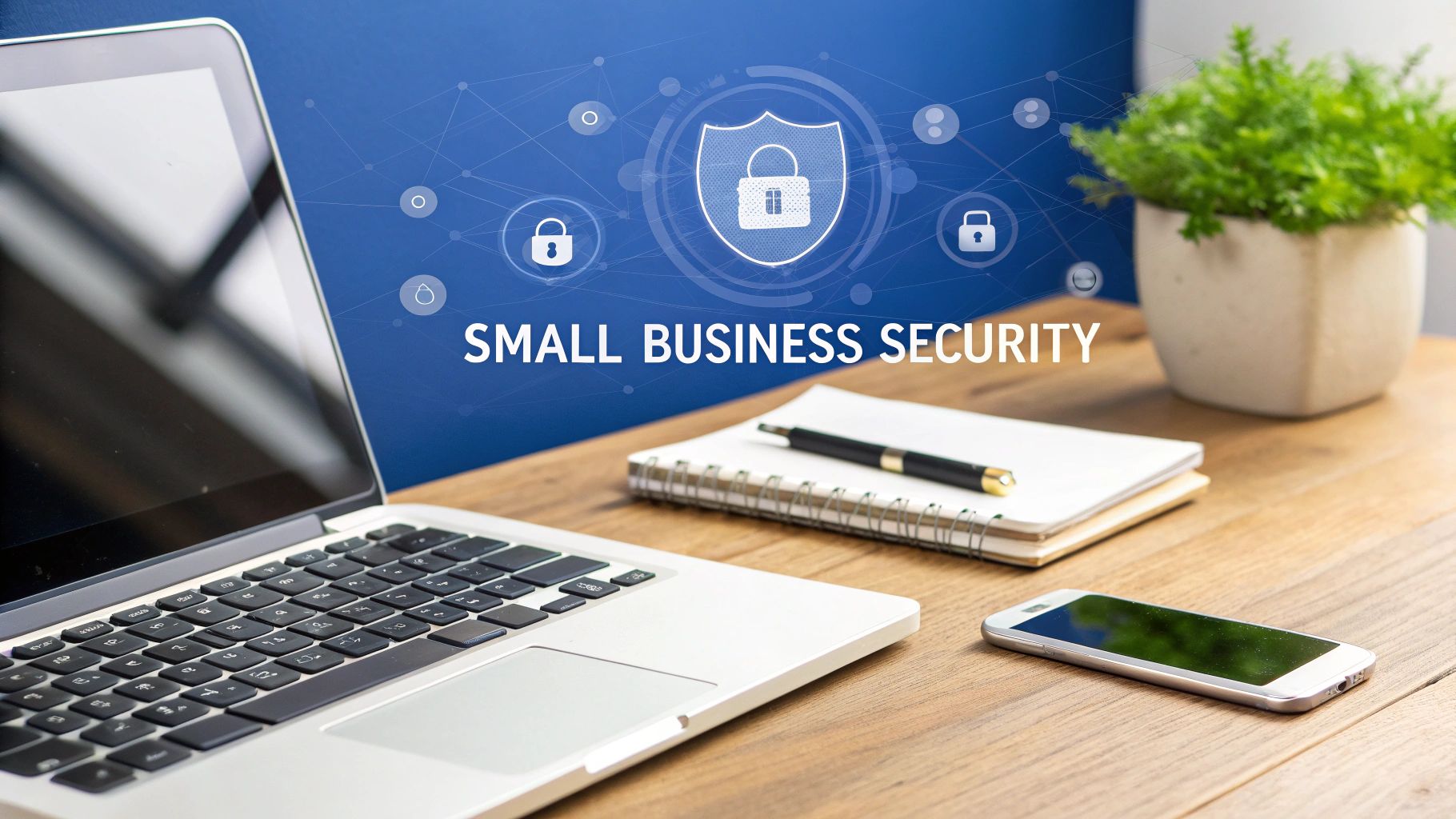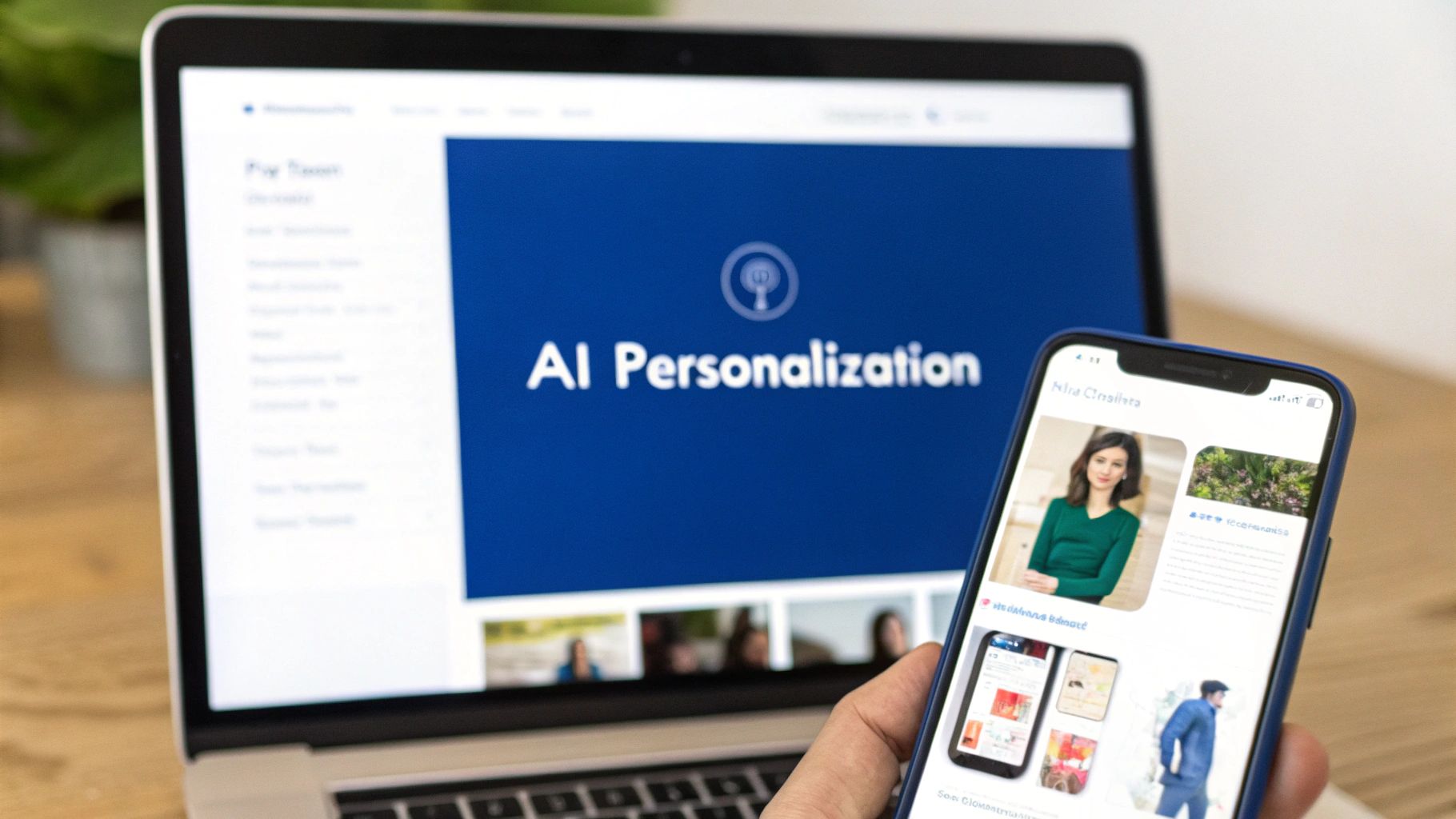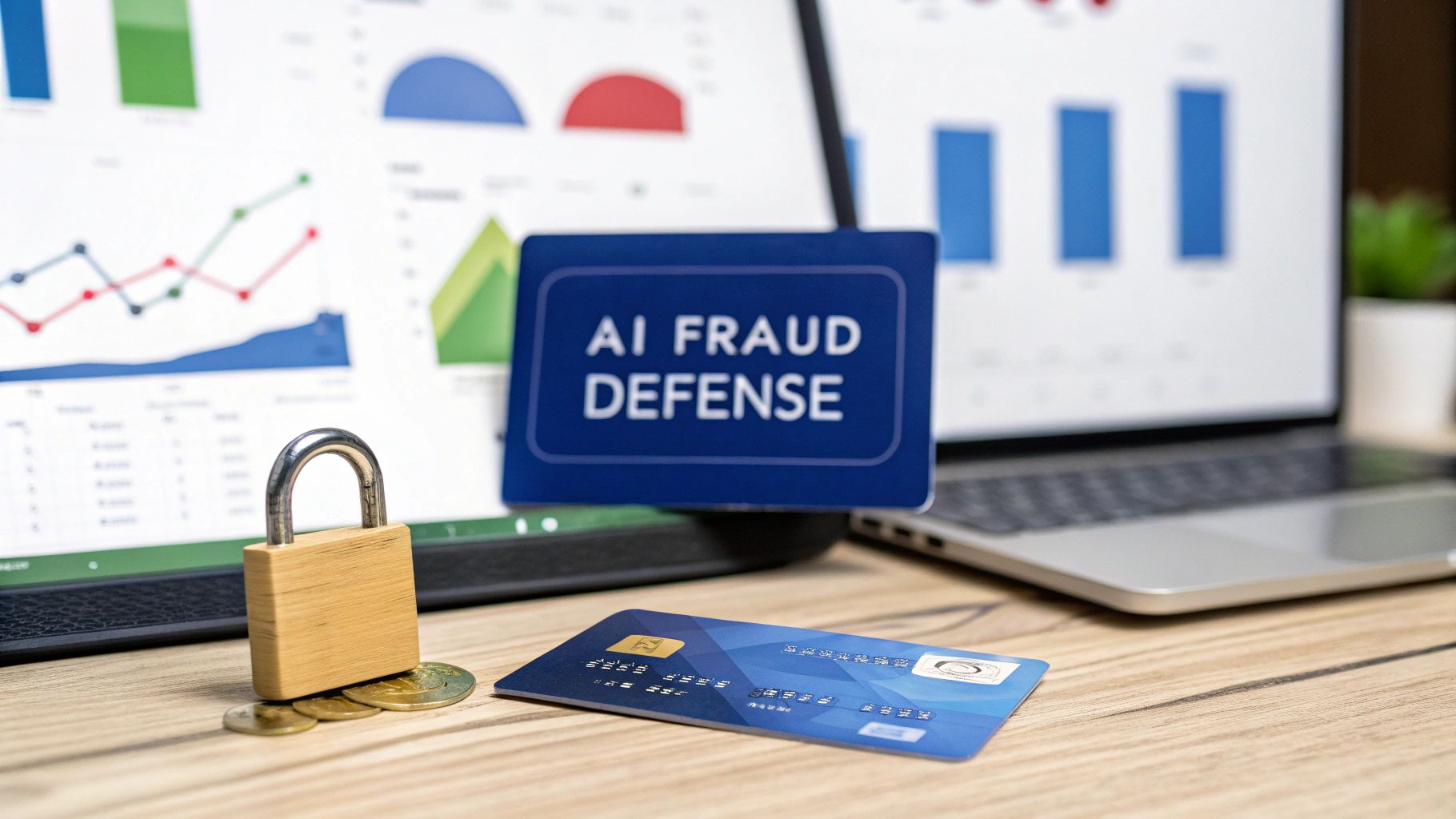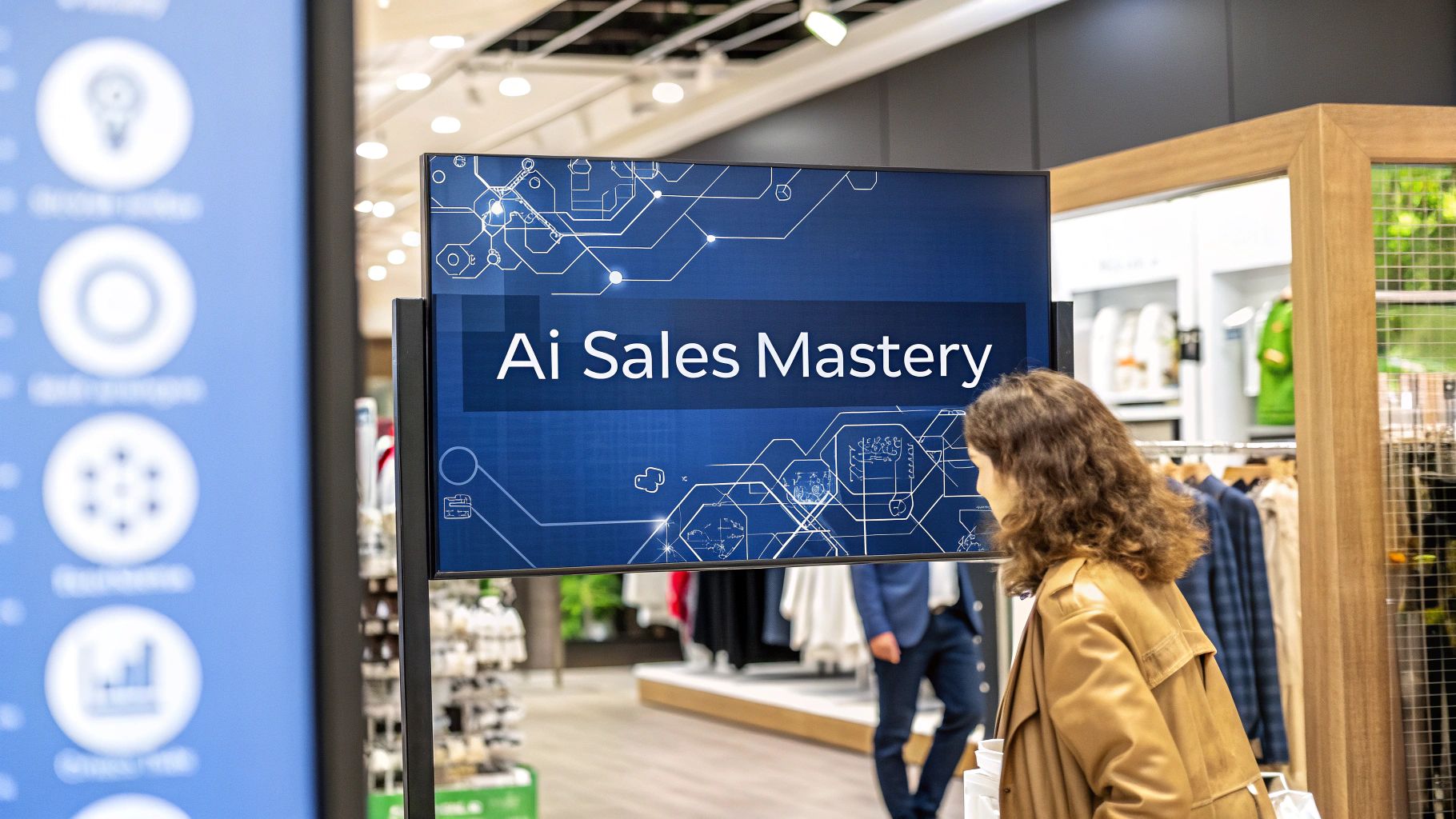For a lot of entrepreneurs, the idea of robust cyber security for small business feels like a problem reserved for the big players. The reality is quite the opposite. Cybercriminals often see small businesses as the path of least resistance, juicy targets precisely because they assume they’re flying under the radar.
Why Cyber Security is No Longer Optional
The most dangerous myth making the rounds in the small business community is the idea that “we’re too small to be a target.” This kind of thinking is like leaving the front door of your shop unlocked overnight. Attackers love finding these easy opportunities.
Picture this: a local bakery, built on years of neighbourhood trust, suddenly finds its customer orders, payment systems, and financial records encrypted and held for ransom. This isn’t just a technical headache; it’s a direct hit to its reputation, customer loyalty, and its very ability to stay in business.
This isn’t just a scare story. In California, over 50% of small businesses were hit by at least one cyber attack last year. The financial fallout was significant, with losses typically landing between $84,000 and $148,000 per incident. Even with these numbers, a shocking 59% of owners still believe they are too small to be targeted.
The Myth of Single-Layer Protection
Too many businesses think installing antivirus software is all it takes to be secure. That’s like locking your front door but leaving all the windows wide open. Today’s cyber threats are sophisticated and come from all angles, like phishing scams, malware, and clever email compromises, and a single tool just can’t catch everything. Real security means creating multiple barriers to entry.
A layered defence strategy means that if one security measure fails, others are ready to step in and stop an attack in its tracks. It moves you away from having a single point of failure and toward a more resilient, overlapping system of protection.
From Unnecessary Expense to Essential Investment
Thinking of cybersecurity as just another IT cost is a fundamental mistake. It’s an investment in your company’s survival, its reputation, and its future. A proactive security plan protects your most valuable asset, .ie, your data, and maintains the trust you’ve worked so hard to build with your customers. The conversation around SMBs’ need for affordable manual pentests shows just how crucial it is to find weak spots before attackers do.
Ultimately, it’s time to change the question from “if” an attack will happen to being prepared for “when” it does. This mindset shift is what empowers you to take control. A smart Cyber Security and Compliance Services strategy isn’t about operating from a place of fear; it’s about building a resilient business ready for modern digital challenges. For a broader look at protective measures, our Cyber Security Services offer a foundational overview. Learn more about our mission to secure businesses like yours on our about us page.
Understanding Today’s Digital Threats

Before you can defend your business, you need to know what you’re up against. The world of cyber threats might seem impossibly complex, but most attacks boil down to a few key strategies: deception and exploiting human nature.
By learning to recognize the most common attack methods, you turn basic awareness into your first and most powerful line of defence.
Think of it like this: a con artist calls you pretending to be from your bank, spinning a convincing story to get your account details. Phishing is the digital version of that exact scam. Instead of a phone call, it’s a cleverly disguised email or a fake website designed to steal your information.
The Evolution of Phishing and Social Engineering
Forget the poorly spelled spam of the past. Today’s criminals are master storytellers, crafting urgent scenarios that push you to act first and think later. They might send an email that looks like it’s from a key supplier, a government agency, or even your own bank, warning you of a problem that needs immediate attention.
This tactic is called social engineering. It’s less about hacking code and more about hacking people. Attackers manipulate emotions like fear, curiosity, or a desire to be helpful, tricking you or your team into making a critical security mistake.
A particularly nasty variation of this is Business Email Compromise (BEC). Imagine your finance manager gets an email that looks like it’s from you, the CEO. It’s marked “Urgent & Confidential” and asks for an immediate wire transfer to a new vendor. Without strict procedures to verify these requests, it’s frighteningly easy for someone to fall for it.
Ransomware: The Digital Hostage Situation
Ransomware is one of the most devastating threats a small business can face. In simple terms, it’s a digital kidnapping of your most valuable data.
Once it gets into your network, this malicious software scrambles everything, such as customer lists, financial records, operational files, and locks it all behind unbreakable encryption. Your business is instantly paralyzed.
The attackers then pop up with a demand for a hefty ransom, usually in untraceable cryptocurrency, in exchange for the key to unlock your files. But paying is a huge gamble. There’s no guarantee you’ll get your data back, and it flags your business as an easy target for future attacks.
The true cost of a ransomware attack goes far beyond the ransom demand. It’s the crippling downtime, the shattered customer trust, and the very real risk of your business not surviving the recovery process.
AI and Supply Chain Vulnerabilities
The attackers’ toolkit is getting smarter all the time. Artificial Intelligence (AI) is now being used to automate and personalize attacks on a massive scale. AI can craft phishing emails that are practically indistinguishable from the real thing or even create “deepfake” audio messages that mimic a trusted colleague’s voice.
Your security isn’t just about locking your own doors, either. What about your suppliers? A supply chain attack happens when a hacker breaks into one of your trusted vendors, like your IT provider or a software tool you use, and uses that access as a secret backdoor into your own network.
You could have the strongest defences in the world, but if a partner is compromised, you become vulnerable by association. This is why thoroughly vetting your technology partners is non-negotiable. To stay ahead, it’s crucial to keep up with how these tactics are changing, which you can do by reading our post on cybersecurity trends for digital threats.
Building Your Foundational Defence Plan
Knowing the threats you face is one thing, but translating that knowledge into a solid action plan is what will actually keep your business safe. A robust defence isn’t about buying one expensive piece of software and calling it a day. Instead, it’s built by layering multiple security measures that work together, creating a much more resilient barrier.
Think of it as building your security foundation, one essential pillar at a time. The goal isn’t to become an unbreachable fortress; that’s unrealistic for anyone. It’s about making your business a tougher, less attractive target for cybercriminals looking for an easy payday. And that process starts with controlling who can access your digital front door.

Pillar 1: Technical Controls and Access Management
Technical controls are the digital equivalent of locks, alarms, and security guards for your network. They’re the critical tools that automatically monitor, filter, and block malicious activity before it can do any real harm.
- Firewalls: Picture a firewall as the bouncer for your network. It stands at the entrance, checks everyone’s ID (data packets), and turns away anything that looks suspicious or isn’t on the list. It’s your first and most fundamental line of automated defence.
- Multi-Factor Authentication (MFA): Passwords just don’t cut it anymore. MFA adds a simple but powerful second layer of security, like requiring a code from your phone to prove it’s really you. This one step can block 99.9% of automated attacks aimed at taking over accounts.
- Antivirus and Anti-Malware Software: This is the non-negotiable software that sniffs out and neutralizes malicious programs on your computers. Make sure it’s installed on every company device and, crucially, that it’s always kept up-to-date. New threats emerge daily, and outdated software is an open invitation.
These tools are the bedrock of your defence, but they’re only as good as the processes guiding them. You can dive deeper into these principles in our guide on software security best practices.
Pillar 2: Procedural Security and Data Integrity
While technology gives you the tools, your internal rules and daily habits determine how effective they are. Procedural security is all about creating smart, repeatable processes that minimize human error, a factor that plays a role in over 74% of all data breaches.
A strong password policy is a great place to start. This means requiring long, complex, and unique passwords for every single application. Ban password reuse across different services and get your team on board with a password manager to securely store their credentials.
Next, you need a bulletproof data backup and recovery plan. This is your ultimate safety net if you ever get hit with ransomware. The gold standard here is the 3-2-1 rule: keep three separate copies of your data, on two different types of media, with one of those copies stored completely off-site (like in the cloud). Just as important, test your backups regularly to make sure you can actually restore your data when you need it most.
A well-tested backup plan is the difference between a ransomware attack being a minor inconvenience and a business-ending catastrophe. It transforms a hostage situation into a simple restoration process, giving you the power to recover without paying a cent.
For your company’s online presence, implementing key website security best practices is another critical piece of building this foundational defence.
Prioritizing Your Security Measures
With a limited budget and even more limited time, it’s easy to feel overwhelmed. The key is to focus on the measures that give you the most bang for your buck by tackling the most common threats first.
To help you get started, here’s a quick breakdown of the essentials.
Essential Cyber Security Measures for Small Businesses
This table outlines the foundational controls every small business should have in place, what they do, and which major threats they stop.
| Security Measure | What It Does | Primary Threat Mitigated |
|---|---|---|
| Multi-Factor Authentication | Requires a second form of verification to log in, proving your identity beyond just a password. | Account Takeover, Phishing |
| Regular Data Backups | Creates secure copies of your critical business data, allowing you to restore it after an incident. | Ransomware, Data Loss |
| Employee Security Training | Educates your team to recognize and report phishing attempts and other social engineering tactics. | Phishing, Business Email Compromise |
| Software Patching & Updates | Applies the latest security fixes to your software and operating systems, closing known vulnerabilities. | Malware, Exploits |
| Network Firewall | Monitors and controls incoming and outgoing network traffic, blocking unauthorized access and threats. | Unauthorized Access, Malware |
By focusing on these core pillars, you’re not just buying products; you’re building a resilient security culture that can adapt and protect your business for the long haul.
Your Team: The Human Side of Security
Technology is a powerful shield, but it’s far from perfect. Think about it: the strongest, most expensive firewall in the world can be completely undone by one convincing phishing email. This is why your employees are the day-to-day guardians of your sensitive data, making them a critical piece of your defence strategy. Building a security-conscious culture isn’t just a nice-to-have; it’s one of the most effective investments you can make in cyber security for small business.
The goal here is to shift your team from being a potential weak link to becoming your most alert and active defence. It all starts with ongoing education and creating an environment where security is everyone’s job, not just a problem for the IT department. As we explored in our cybersecurity adoption guide, empowering your people acts as a massive boost for all your technical defences.
Cultivating a Security-First Mindset
Creating a “human firewall” is all about practical, relatable training that helps your team spot threats during their regular workday. This has nothing to do with memorizing technical jargon and everything to do with building smart, reflexive security habits.
- Spotting Suspicious Emails: Teach everyone to give emails a second look, especially for red flags. This includes unexpected attachments, pushy requests for sensitive info, sender names that don’t quite match the email address, and generic greetings like “Dear Customer.”
- Adopting Smart Password Habits: A strong password policy is non-negotiable. Insist on long, complex, and unique passwords for every single service. A password manager is the perfect tool for this, letting employees generate and store rock-solid credentials without the headache of remembering them all.
- Handling Sensitive Information: Be crystal clear about how customer data, financial records, and other private information should be managed, shared, and stored. Make sure every single person understands why protecting this data is so important, whether they’re in the office or working remotely.
The Zero Trust Approach: Never Trust, Always Verify
A game-changing concept to introduce is Zero Trust. It’s time to throw out the old idea of a “safe” internal network and a “dangerous” outside world. In today’s reality, you have to assume that threats can pop up from anywhere, even from within your own walls.
The motto is simple but powerful: “Never trust, always verify.”
In practice, this means every single request to access data or systems must be checked and approved, no matter where it comes from. It forces users to prove they are who they claim to be and that they have explicit permission for the specific file or app they’re trying to use. This approach makes it incredibly difficult for an attacker to move around your network, even if they manage to sneak past the front door by compromising one account.
Creating a Simple Incident Response Plan
Even with the best defences in place, a security incident can still happen. When it does, panic is your absolute worst enemy. Having a simple, clear incident response plan ready to go ensures your team can react calmly and effectively, which helps minimize the damage and gets you back on your feet faster.
Your plan doesn’t need to be a massive, hundred-page document. Just start with the basics:
- Identify and Contain: Who on the team is in charge of spotting a potential breach and immediately taking steps to isolate the affected computers or systems?
- Assess and Eradicate: How will you figure out the extent of the damage and kick the threat out of your network for good?
- Notify and Report: Who needs to be told (like leadership, customers, or your lawyer) and how quickly?
- Recover and Learn: What are the steps to restore normal operations from clean backups? Most importantly, what lessons can be learned to stop this from ever happening again?
Having this roadmap prepared means your team can act with purpose instead of fear. When you focus on both your technology and your people, you build a much tougher, more resilient security stance. For businesses looking for a complete strategy, our Cyber Security and Compliance Services offer expert guidance. To learn more about how we approach security, feel free to visit our about us page.
Navigating Data Protection and Compliance

For many small business owners, the world of data protection and legal compliance can feel like a maze. It’s easy to think that regulations like Canada’s Personal Information Protection and Electronic Documents Act (PIPEDA) are only for big corporations. The reality is, they apply to any business, no matter its size, that collects, uses, or discloses personal information during its commercial activities.
Getting a handle on these rules is crucial. At their heart, these laws are about respecting your customers’ privacy and proving you’re a trustworthy steward of their data. This isn’t just about ticking a legal box; it’s about building a foundation of trust that creates lasting customer relationships. When people know you take their privacy seriously, they’re far more likely to do business with you.
Core Principles of Data Compliance
Think of compliance as a promise you make to your customers. You promise to protect their data, be open about how you use it, and give them control over their own information.
This promise directly shapes your day-to-day operations. It means you have to put reasonable security measures in place to protect the personal information you hold. This ties right back to the foundational defence plan we talked about earlier, showing just how important a layered approach to cybersecurity for small businesses really is.
Compliance is more than just avoiding fines; it’s a powerful competitive advantage. Demonstrating a strong commitment to data protection can set you apart from competitors and become a key reason why customers choose you.
A huge part of this is having a clear, easy-to-find privacy policy. This document should explain in simple terms what information you collect, why you collect it, and how you keep it safe. That kind of transparency is a powerful trust-builder.
Your Responsibilities in Case of a Breach
Even with the best defences, breaches can happen. A key part of being compliant is knowing exactly what to do if one occurs. Under PIPEDA, your business is required to report any breach of your security safeguards that creates a real risk of significant harm to people.
This means you have to notify the affected individuals and the Office of the Privacy Commissioner of Canada. Having an incident response plan ready before something happens allows you to act quickly and professionally, meeting your legal duties while managing the crisis. The process can be tricky, which is why professional Cyber Security and Compliance Services can be a lifesaver in helping you navigate these requirements.
A Simple Compliance Self-Check
Want a quick sense of where you stand? Run through these simple questions. It’s not a full audit, but it’s a great way to spot areas that might need some attention.
- Do we know what personal data we collect and why? You should only be gathering what’s necessary for your business.
- Is our customer data stored securely? Think about encryption, access controls, and other security measures.
- Do we have a clear and public privacy policy? Can customers easily find it and understand it?
- Do we have a process for handling data access requests? People have a right to see the personal information you hold on them.
- Do we have a plan for reporting a data breach? Knowing the steps before a crisis hits is essential.
By working through these points, you start to see compliance not as a chore, but as a strategic tool to strengthen your business and build trust.
Finding the Right Cyber Security Partner
Eventually, most small businesses hit a wall. You realise that trying to manage security on your own, between everything else you have to do, just isn’t cutting it anymore. Leaping at a DIY approach to working with a professional is a huge step, but it’s a smart one that protects your hard-earned investment and frees you up to actually run your business.
But here’s the thing: picking the right security expert or managed service provider (MSP) is a decision you can’t rush. You’re looking for a true partner, not just another vendor on your payroll. This means finding someone who gets your industry, understands your daily operational headaches, and respects your budget. A cookie-cutter security package is a red flag; a real partner will want to learn the ins and outs of your company before they even whisper the word “solution.”
Key Questions to Ask Potential Partners
When you start talking to potential security firms, you need to dig deeper than their slick sales pitch. Your questions should cut through the jargon and get to the heart of their expertise, honesty, and how they’ll react when things go wrong.
Here are a few essential questions to get the conversation started:
- What’s your experience with businesses of our size and in our industry? You need to know they understand the specific threats and compliance rules you face, not just the ones big corporations worry about.
- Walk me through your process when a security incident happens. Ask for a play-by-play of their incident response plan, from the moment they detect a threat to how they get you back up and running.
- What kind of reporting and communication should we expect? You need clear, consistent updates on your security status. It’s the only way to know you’re getting what you paid for.
- How do you keep up with new threats? The best partners are always learning, constantly refining their strategies to stay one step ahead of the bad guys.
The Long-Term Value of Expert Guidance
Bringing in a trusted firm is about more than just tech support. It’s about peace of mind. It’s about having the foresight to avoid problems and saving a ton of money by preventing a breach in the first place. The fallout from an attack can be devastating. A recent Mastercard survey revealed that about 20% of small businesses that were attacked had to close their doors for good.
Beyond the immediate financial loss, 80% said they struggled to rebuild trust with their clients and partners. That kind of damage can linger for years. You can read the full findings on small business cybersecurity to really grasp the gravity of these risks.
When you entrust your security to experts, you get to shift your focus from defence back to growth. It gives you the confidence to innovate, serve your customers, and build your business, knowing your digital foundation is solid.
Ultimately, the right partnership turns cybersecurity for small businesses from a nagging, reactive chore into a powerful strategic advantage. To learn more about how we help protect businesses like yours, we invite you to visit our about us page.
Frequently Asked Questions
It’s completely normal to have questions when you’re trying to get a handle on cybersecurity. Let’s tackle some of the most common ones we hear from small business owners, giving you clear, straightforward answers to help you protect what you’ve built.
How Much Should We Really Budget for Cyber Security?
There’s no one-size-fits-all answer here. Your budget depends entirely on your specific situation: what industry you’re in, the sensitivity of the data you manage, and your unique risks. Think of it less like a fixed percentage and more like a strategic investment.
The best place to start is with a risk assessment. This isn’t about spending a fortune; it’s about figuring out where your biggest weaknesses are. Once you know that, you can put your money where it counts the most, focusing on the tools and practices that will actually make a difference for your business. It’s a smarter, more cost-effective way to build your defences.
If We Can Only Do One Thing, What’s the Most Important Security Measure?
While a multi-layered defence is always the goal, if you’re looking for the single biggest bang for your buck, it’s Multi-Factor Authentication (MFA). Hands down.
Turn on MFA for every account and service you can, like email, banking, cloud storage, social media, you name it. It creates a critical roadblock for attackers. Even if a cybercriminal gets their hands on a password, MFA can stop them dead in their tracks. It’s a simple, inexpensive step that dramatically boosts your security.
Can I Handle This Myself, or Do I Need to Hire an Expert?
You can definitely manage the basics. Things like enforcing strong password policies, keeping all your software up to date, and using a good antivirus program are foundational steps every business owner can and should take.
However, the reality is that the threats out there are constantly evolving. Partnering with a firm that specializes in cybersecurity for small businesses brings a level of expertise, advanced tools, and round-the-clock monitoring that’s incredibly difficult to replicate on your own. A pro can design a solid strategy that not only prevents a catastrophic breach but also frees you up to focus on running your business. You can see how we approach this on our about us page.








